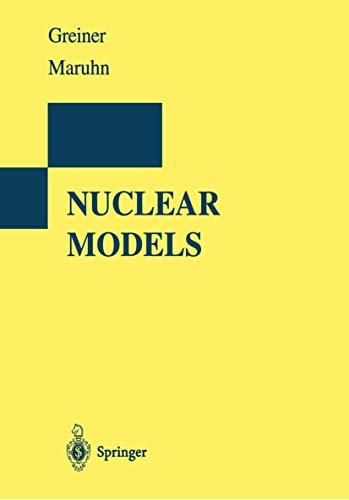Articoli correlati a Nuclear Models

Theoretical physics has become a many-faceted science. For the young student it is difficult enough to cope with the overwhelming amount of new scientific material that has to be learned, let alone to obtain an overview of the entire field, which ranges from mechanics through electrodynamics, quantum mechanics, field theory, nuclear and heavy-ion science, statistical mechanics, thermodynamics, and solid state theory to elementary-particle physics. And this knowledge should be acquired in just 8-10 semesters during which, in addition, a Diploma or Master's thesis has to be worked on or examinations prepared for. All this can be achieved only if the university teachers help to introduce the student to the new disciplines as early on as possible, in order to create interest and excitement that in turn set free essential new energy. Naturally, all inessential material must simply be eliminated. At the Johann Wolfgang Goethe University in Frankfurt we therefore confront the student with theoretical physics immediately in the first semester. Theoretical Mechanics I and II, Electrodynamics, and Quantum Mechanics I - an Introduction are the basic courses during the first two years. These lectures are supplemented with many mathematical explanations and much support material. After the fourth semester of studies, graduate work begins and Quantum Mechanics II - Symme tries, Statistical Mechanics and Thermodynamics, Relativistic Quantum Mechanics, Quantum Electrodynamics, the Gauge Theory of Weak Interactions, and Quantum Chromodynamics are obligatory.
Le informazioni nella sezione "Riassunto" possono far riferimento a edizioni diverse di questo titolo.
Contenuti:
1. Introduction.- 1.1 Nuclear Structure Physics.- 1.2 The Basic Equation.- 1.3 Microscopic versus Collective Models.- 1.4 The Role of Symmetries.- 2. Symmetries.- 2.1 General Remarks.- 2.2 Translation.- 2.2.1 The Operator for Translation.- 2.2.2 Translational Invariance.- 2.2.3 Many-Particle Systems.- 2.3 Rotation.- 2.3.1 The Angular Momentum Operators.- 2.3.2 Representations of the Rotation Group.- 2.3.3 The Rotation Matrices.- 2.3.4 SU(2) and Spin.- 2.3.5 Coupling of Angular Momenta.- 2.3.6 Intrinsic Angular Momentum.- 2.3.7 Tensor Operators.- 2.3.8 The Wigner-Eckart Theorem.- 2.3.9 6j and 9j Symbols.- 2.4 Isospin.- 2.5 Parity.- 2.5.1 Definition.- 2.5.2 Vector Fields.- 2.6 Time Reversal.- 3. Second Quantization.- 3.1 General Formalism.- 3.1.1 Motivation.- 3.1.2 Second Quantization for Bosons.- 3.1.3 Second Quantization for Fermions.- 3.2 Representation of Operators.- 3.2.1 One-Particle Operators.- 3.2.2 Two-Particle Operators.- 3.3 Evaluation of Matrix Element for Fermions.- 3.4 The Particle-Hole Picture.- 4. Group Theory in Nuclear Physics.- 4.1 Lie Groups and Lie Algebras.- 4.2 Group Chains.- 4.3 Lie Algebras in Second Quantization.- 5. Electromagnetic Moments and Transitions.- 5.1 Introduction.- 5.2 The Quantized Electromagnetic Field.- 5.3 Radiation Fields of Good Angular Momentum.- 5.3.1 Solutions of the Scalar Helmholtz Equation.- 5.3.2 Solutions of the Vector Helmholtz Equation.- 5.3.3 Properties of the Multipole Fields.- 5.3.4 Multipole Expansion of Plane Waves.- 5.4 Coupling of Radiation and Matter.- 5.4.1 Basic Matrix Elements.- 5.4.2 Multipole Expansion of the Matrix Elements and Selection Rules.- 5.4.3 Siegert’s Theorem.- 5.4.4 Matrix Elements for Emission in the Long-Wavelength Limit.- 5.4.5 Relative Importance of Transitions and Weisskopf Estimates.- 5.4.6 Electric Multipole Moments.- 5.4.7 Effective Charges.- 6. Collective Models.- 6.1 Nuclear Matter.- 6.1.1 Mass Formulas.- 6.1.2 The Fermi-Gas Model.- 6.1.3 Density-Functional Models.- 6.2 Nuclear Surface Deformations.- 6.2.1 General Parametrization.- 6.2.2 Types of Multipole Deformations.- 6.2.3 Quadrupole Deformations.- 6.2.4 Symmetries in Collective Space.- 6.3 Surface Vibrations.- 6.3.1 Vibrations of a Classical Liquid Drop.- 6.3.2 The Harmonic Quadrupole Oscillator.- 6.3.3 The Collective Angular-Momentum Operator.- 6.3.4 The Collective Quadrupole Operator.- 6.3.5 The Quadrupole Vibrational Spectrum.- 6.4 Rotating Nuclei.- 6.4.1 The Rigid Rotor.- 6.4.2 The Symmetric Rotor.- 6.4.3 The Asymmetric Rotor.- 6.5 The Rotation-Vibration Model.- 6.5.1 Classical Energy.- 6.5.2 Quantal Hamiltonian.- 6.5.3 Spectrum and Eigenfunctions.- 6.5.4 Moments and Transition Probabilities.- 6.6 ?-Unstable Nuclei.- 6.7 More General Collective Models for Surface Vibrations.- 6.7.1 The Generalized Collective Model.- 6.7.2 Proton-Neutron Vibrations.- 6.7.3 Higher Multipoles.- 6.8 The Interacting Boson Model.- 6.8.1 Introduction.- 6.8.2 The Hamiltonian.- 6.8.3 Group Chains.- 6.8.4 The Casimir Operators.- 6.8.5 The Dynamical Symmetries.- 6.8.6 Transition Operators.- 6.8.7 Extended Versions of the IBA.- 6.8.8 Comparison to the Geometric Model.- 6.9 Giant Resonances.- 6.9.1 Introduction.- 6.9.2 The Goldhaber-Teller Model.- 6.9.3 The Steinwedel-Jensen Model.- 6.9.4 Applications.- 7. Microscopic Models.- 7.1 The Nucleon-Nucleon Interaction.- 7.1.1 General Properties.- 7.1.2 Functional Form.- 7.1.3 Interactions from Nucleon-Nucleon Scattering.- 7.1.4 Effective Interactions.- 7.2 The Hartree—Fock Approximation.- 7.2.1 Introduction.- 7.2.2 The Variational Principle.- 7.2.3 The Slater-Determinant Approximation.- 7.2.4 The Hartree—Fock Equations.- 7.2.5 Applications.- 7.2.6 The Density Matrix Formulation.- 7.2.7 Constrained Hartree—Fock.- 7.2.8 Alternative Formulations and Three-Body Forces.- 7.2.9 Hartree—Fock with Skyrme Forces.- 7.3 Phenomenological Single-Particle Models.- 7.3.1 The Spherical-Shell Model.- 7.3.2 The Deformed-Shell Model.- 7.4 The Relativistic Mean-Field Model.- 7.4.1 Introduction.- 7.4.2 Formulation of the Model.- 7.4.3 Applications.- 7.5 Pairing.- 7.5.1 Motivation.- 7.5.2 The Seniority Model.- 7.5.3 The Quasispin Model.- 7.5.4 The BCS Model.- 7.5.5 The Bogolyubov Transformation.- 7.5.6 Generalized Density Matrices.- 8. Interplay of Collective and Single-Particle Motion.- 8.1 The Core-plus-Particle Models.- 8.1.1 Basic Considerations.- 8.1.2 The Weak-Coupling Limit.- 8.1.3 The Strong-Coupling Approximation.- 8.1.4 The Interacting Boson—Fermion Model.- 8.2 Collective Vibrations in Microscopic Models.- 8.2.1 The Tamm—Dancoff Approximation.- 8.2.2 The Random-Phase Approximation (RPA).- 8.2.3 Time-Dependent Hartree—Fock and Linear Response.- 9. Large-Amplitude Collective Motion.- 9.1 Introduction.- 9.2 The Macroscopic-Microscopic Method.- 9.2.1 The Liquid-Drop Model.- 9.2.2 The Shell-Correction Method.- 9.2.3 Two-Center Shell Models.- 9.2.4 Fission in Self-Consistent Models.- 9.3 Mass Parameters and the Cranking Model.- 9.3.1 Overview.- 9.3.2 The Irrotational-Flow Model.- 9.3.3 The Cranking Formula.- 9.3.4 Applications of the Cranking Formula.- 9.4 Time-Dependent Hartree—Fock.- 9.5 The Generator-Coordinate Method.- 9.6 High-Spin States.- 9.6.1 Overview.- 9.6.2 The Cranked Nilsson Model.- Appendix: Some Formulas from Angular-Momentum Theory.- References.
Product Description:
Book by Greiner Walter Maruhn Joachim A
Le informazioni nella sezione "Su questo libro" possono far riferimento a edizioni diverse di questo titolo.
- EditoreSpringer Verlag
- Data di pubblicazione2008
- ISBN 10 3540780467
- ISBN 13 9783540780465
- RilegaturaCopertina flessibile
- Numero di pagine392
- Valutazione libreria
(nessuna copia disponibile)
Cerca: Inserisci un desiderataSe non trovi il libro che cerchi su AbeBooks possiamo cercarlo per te automaticamente ad ogni aggiornamento del nostro sito. Se il libro è ancora reperibile da qualche parte, lo troveremo!
Inserisci un desiderata
